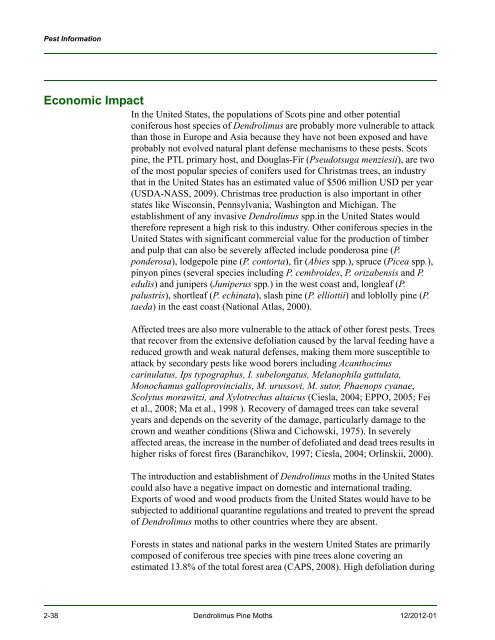New Pest Response Guidelines - aphis - US Department of Agriculture
New Pest Response Guidelines - aphis - US Department of Agriculture
New Pest Response Guidelines - aphis - US Department of Agriculture
You also want an ePaper? Increase the reach of your titles
YUMPU automatically turns print PDFs into web optimized ePapers that Google loves.
<strong>Pest</strong> Information<br />
Economic Impact<br />
In the United States, the populations <strong>of</strong> Scots pine and other potential<br />
coniferous host species <strong>of</strong> Dendrolimus are probably more vulnerable to attack<br />
than those in Europe and Asia because they have not been exposed and have<br />
probably not evolved natural plant defense mechanisms to these pests. Scots<br />
pine, the PTL primary host, and Douglas-Fir (Pseudotsuga menziesii), are two<br />
<strong>of</strong> the most popular species <strong>of</strong> conifers used for Christmas trees, an industry<br />
that in the United States has an estimated value <strong>of</strong> $506 million <strong>US</strong>D per year<br />
(<strong>US</strong>DA-NASS, 2009). Christmas tree production is also important in other<br />
states like Wisconsin, Pennsylvania, Washington and Michigan. The<br />
establishment <strong>of</strong> any invasive Dendrolimus spp.in the United States would<br />
therefore represent a high risk to this industry. Other coniferous species in the<br />
United States with significant commercial value for the production <strong>of</strong> timber<br />
and pulp that can also be severely affected include ponderosa pine (P.<br />
ponderosa), lodgepole pine (P. contorta), fir (Abies spp.), spruce (Picea spp.),<br />
pinyon pines (several species including P. cembroides, P. orizabensis and P.<br />
edulis) and junipers (Juniperus spp.) in the west coast and, longleaf (P.<br />
palustris), shortleaf (P. echinata), slash pine (P. elliottii) and loblolly pine (P.<br />
taeda) in the east coast (National Atlas, 2000).<br />
Affected trees are also more vulnerable to the attack <strong>of</strong> other forest pests. Trees<br />
that recover from the extensive defoliation caused by the larval feeding have a<br />
reduced growth and weak natural defenses, making them more susceptible to<br />
attack by secondary pests like wood borers including Acanthocinus<br />
carinulatus, Ips typographus, I. subelongatus, Melanophila guttulata,<br />
Monochamus galloprovincialis, M. urussovi, M. sutor, Phaenops cyanae,<br />
Scolytus morawitzi, and Xylotrechus altaicus (Ciesla, 2004; EPPO, 2005; Fei<br />
et al., 2008; Ma et al., 1998 ). Recovery <strong>of</strong> damaged trees can take several<br />
years and depends on the severity <strong>of</strong> the damage, particularly damage to the<br />
crown and weather conditions (Sliwa and Cichowski, 1975). In severely<br />
affected areas, the increase in the number <strong>of</strong> defoliated and dead trees results in<br />
higher risks <strong>of</strong> forest fires (Baranchikov, 1997; Ciesla, 2004; Orlinskii, 2000).<br />
The introduction and establishment <strong>of</strong> Dendrolimus moths in the United States<br />
could also have a negative impact on domestic and international trading.<br />
Exports <strong>of</strong> wood and wood products from the United States would have to be<br />
subjected to additional quarantine regulations and treated to prevent the spread<br />
<strong>of</strong> Dendrolimus moths to other countries where they are absent.<br />
Forests in states and national parks in the western United States are primarily<br />
composed <strong>of</strong> coniferous tree species with pine trees alone covering an<br />
estimated 13.8% <strong>of</strong> the total forest area (CAPS, 2008). High defoliation during<br />
2-38 Dendrolimus Pine Moths 12/2012-01

















